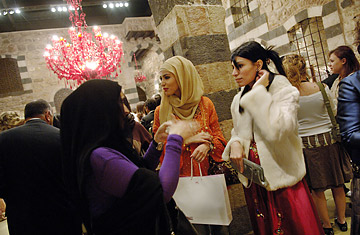
Guests gather around for the opening party for luxury boutique Villa Moda's branch in Damascus.
(3 of 3)
Today Lomar has two stores, and it will open five more, including ones in Bahrain and Dubai, later this year. The brand's big breakthrough was replacing the traditional buttons with a zipper. Plus, the brand offers activity-specific thobes: Beach, with its fast-drying fabric, is sold for a day at the seaside. Walk boasts a rubber-band hem for exercising. While Bougary says the brand would never "draw faces or bodies" on its designs—figurative art like this may be frowned upon in some Islamic countries—a recent collection, Tattoo, featured an unusual graffiti-like motif. A few conservatives complained, but Bougary says it only cements Lomar's street credibility. "Wearing Lomar says, 'I am Saudi, but I am a progressive Saudi,'" he insists.
The next obvious step would be women's wear. "With the women's side, it's bordering on something religious," says Bougary hesitantly. "We thought about it, but in the end we think we are better concentrating on thobes."
Both niqabis and muhajababes source the rules for modest dress to the same handful of verses from the Koran and the Hadith, as the examples of Muhammad's life are known. One of the most commonly cited instructions: "Enjoin your wives, your daughters, and the wives of true believers to draw their veils close to them. That is more proper, so that they may be recognized and not be molested." But interpretations of how to apply the recommendations today vary tremendously.
"It doesn't say anything about black," said Jidda-based designer Bin Hejaila, 33, as she settled into a chair at a Starbucks in Paris in December. "I noticed that all the Chanel windows show mannequins wearing head scarves. I was so happy to see that," she said as she opened her laptop and clicked through photographs of her designs in feminine flowing bright silks. The great-granddaughter of a Saudi general who liaised with Lawrence of Arabia, Bin Hejaila launched her line Niyaah (Arabic for intention) with an afternoon fashion show and tea for 250 at a trendy restaurant in Jidda in March 2006. Her website is clear about her priorities: to "serve God and Islam" and promote "dignity through fashion."
"Islamic clothing for women across the Arabian Peninsula historically was rich in color and embroidery," says Bin Hejaila, "so who are these guys in Saudi deciding we must all be in black?" Which is funny because she is in black, from her cap-with-bandanna to her patent-trimmed coat and patent Miu Miu boots.
After studies in the U.S. and a stint at Citibank, Bin Hejaila changed direction, adopting the hijab after a post-9/11 pilgrimage to Mecca in 2001. "I love dressing up and having people around me looking good. At first I found nothing to wear," she says. Others began asking about her mod ensembles, so she signed up for design courses in Italy and hired seamstresses to produce her ideas. Her biggest thrill came when she wore one of her designs, a puff of ruffles, to an international luxury conference and caught the eye of hip New York designer Zac Posen. He paid her the ultimate compliment, she remembers, when he asked, "Is it religion, or is it fashion?"